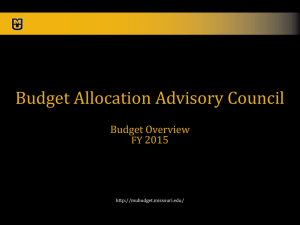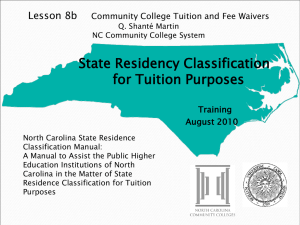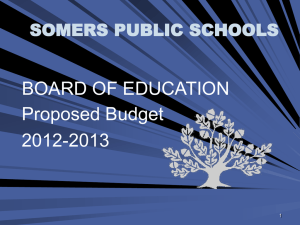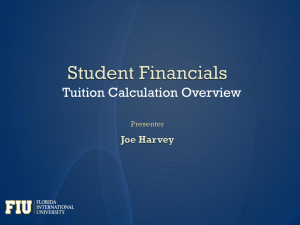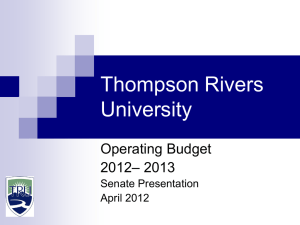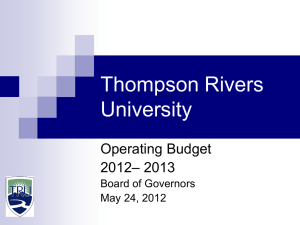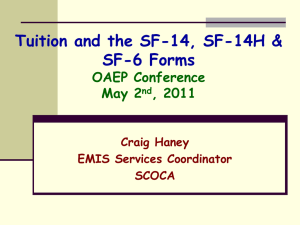Higher Education Finance Part 1-Toutkoushian
advertisement
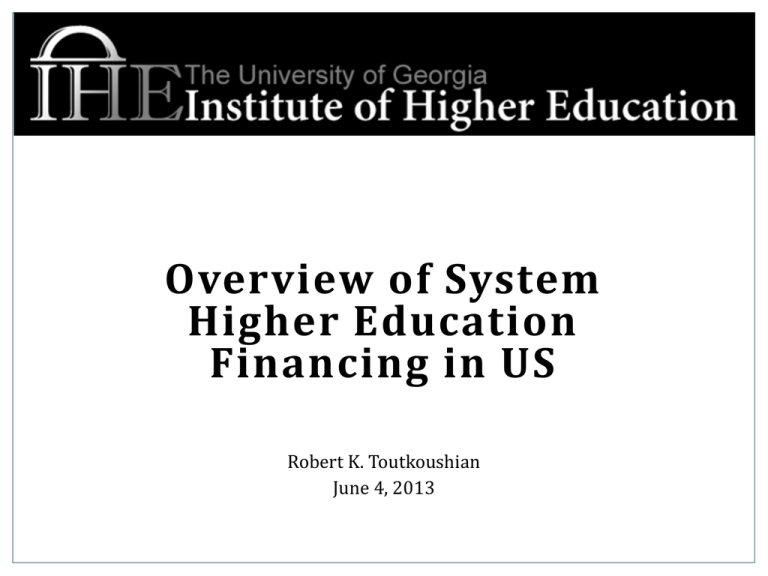
Overview of System Higher Education Financing in US Robert K. Toutkoushian June 4, 2013 My Background Professor of higher education at the Institute of Higher Education, University of Georgia (US) Specialize in economics, finance, quantitative research methods Worked as research analyst for U Minnesota, U System of New Hampshire Consult with institutions and state governments on finance-related issues in education Overview of Presentation First presentation: overview of system higher education financing in the United States Philosophical issues in funding higher education How does US society pay for higher education? The role of data in examining funding policies Second presentation (tomorrow): overview of institutional higher education funding in the US Funding from the perspective of individual institutions Philosophical Issues in Funding Higher education is a resource-dependent service Cost of higher education is paid by individuals Students / families pay through tuition and fees Other individuals pay for higher education through taxes that are used by government to cover some portion of cost Question: Who should pay for this service? “Benefits received principle”: Each entity that benefits from the service should pay a portion of the cost equal to their benefit Higher Education Pricing Economist Gordon Winston offered the following description of pricing in higher education: Price = Cost – Subsidy Price = what students/families pay Cost = what institutions have to pay to provide services Subsidy = all non-student revenues (government, donors) Question: How large are higher education benefits for students and society? Private Benefits from Higher Education On average students / families personally benefit when they acquire more education Financial (“market”) private benefits include: Access to better jobs tied to degree attainment Higher lifetime earnings, higher spousal earnings Lower unemployment rates Non-financial (“non-market”) benefits may include: Greater understanding of the world Entertainment Social and personal development Public Benefits from Higher Education Do others in society benefit when some individuals go to college? Argument: If all benefits are private, then the cost should not be subsidized Governments do not subsidize most of the goods and services that individuals buy because the benefits are solely private in nature In US, there is debate as to whether benefits from higher education are mostly private or public Arguments for Government Funding Goal of government: Raise quality of life of citizens Government may intervene in competitive markets when: Service is a “public good” (non-excludable, non-rival) Examples: national defense, fireworks displays If we let others pay for it…creates the “free rider problem” Government mandates that taxes be used to pay for public goods Basic research at universities can be thought of as a public good produced by higher education Arguments for Government Funding Government may intervene in competitive markets when: Service creates “spillover benefits” to others in society Examples: home improvements, education Positive benefits from education include higher standard of living, lower crime, more active citizens Students only consider private benefits when making education choices, and thus less education would be produced than desired Government provides funding to change student behavior (reduce price paid by student leads more to choose education) Estimates of Financial Benefit to Students from Pursuing a Bachelor’s Degree in the United States, 2011 (US$) Measure of Return to Higher Education Public Institutions Private Institutions Graduates NonGraduates All Students Graduates NonGraduates All Students NPV (0%) $1,246,937 $42,719 $842,040 $1,210,044 $34,868 $930,916 NPV (3%) $523,571 $12,155 $352,651 $488,013 $4,198 $376,657 Ratio (0%) 18.85 3.64 17.98 12.33 2.45 12.69 Ratio (3%) 8.88 1.74 8.41 5.79 1.17 5.91 IROR (0%) 18.1% 5.7% 17.1% 13.7% 3.7% 13.7% NPV (0%) $1,621,370 $43,599 $1,096,526 $1,619,007 $48,081 $1,245,146 NPV (3%) $658,898 $2,963 $444,886 $656,040 $7,180 $505,995 Ratio (0%) 13.07 2.25 12.88 12.84 2.58 13.17 Ratio (3%) 6.16 1.08 6.01 6.02 1.23 6.14 IROR (0%) 14.4% 3.4% 13.9% 14.1% 4.0% 14.1% Private Return Social Return Notes: Values in parentheses denote assumed discount rate for time preference. NPV = net present value of discounted benefits minus costs. Ratio = ratio of discounted benefits to costs. IROR = internal rate of return (non-discounted benefits and costs). Calculations assume that the student is 18 years old and retires at age 65. Gross private benefits include the gain in post-tax incomes over the person’s time in the labor market. Gross social benefits use pre-tax incomes in their calculations. Net benefits subtract the average tuition and fees at 4-year public institutions less average grants and scholarships less government revenues that are used for offsetting instructional costs. It is assumed that the student works part-time during college and earns 10% of the income that could be earned if working full-time. Forms of Government Funding in US In US, state governments have primary responsibility for managing higher education systems Federal (national) government Funding to students based on financial need – 50% Funding to institutions for research – 50% State (regional) government Funding to institutions for operations (“block grant”) -- 90% [Funding leads to lower prices] Funding to students based on need (“need”) – 5% Funding to students based on performance (“merit”) – 5% Effect of State Government Funding on Price Price State Government Appropriations Nonresidents pay PNR Residents from state pay lower price PR Supply Subsidy only used to lower price for state residents PNR PR Demand ENR Tuition Revenue E Enrollments (E) Higher Education Funding States in the US use a variety of approaches to determining how much funding to provide higher education institutions: Formula to meet planned expenditures (Georgia) 2. Formula to keep pace with peer institutions 3. Formula to reward institutional performance 4. No formula – Funding levels determined through political process each year 1. Example of Expenditure Approach Assumptions in funding formula: 1. Institutions need one faculty member for every 800 credit hours taught 2. Target faculty salary = $70,000/faculty member Cost is affected by (a) assumed ratio of credit hours to faculty, and (b) target faculty salary Funding is based on number of faculty positions needed, providing the government with some oversight on expenditures Illustration of Peer Funding Model Peers A B C D E F G H I J Suppose that a public institution has 20,000 students and charges $10,000 tuition Tuition + State Funding / Student $20,000 $19,000 $18,000 $17,000 $16,000 $15,000 $14,500 $14,000 $13,500 $13,000 Ten peer institutions (A through J) from other states are chosen Values show revenue from tuition and state funding per student Target $/Student for Total State Funding Percentile Target Revenue Tuition Funding Needed 50th = $15,500 $310,000,000 $200,000,000 $110,000,000 th 75 = $17,750 $355,000,000 $200,000,000 $155,000,000 Total revenue needed to reach target (20,000 students x target revenue/student) Tuition funding (20,000 students x tuition rate) State funding needed to reach target after subtracting tuition revenue Performance Funding in the US About half of states have experimented with performance-based funding in US Most have allocated only a small percentage of funding (exception: Tennessee) Georgia is moving to performance-based funding Challenge: How to identify appropriate measures of performance Challenge: When funding is small percentage, may not provide much incentive for change Example of Performance Funding: University of Tennessee Knoxville Outcomes Model Summary - UTK Outcome Students Accumulating 24 hrs (Scale=1) Students Accumulating 48 hrs (Scale=1) Students Accumulating 72 hrs (Scale=1) Bachelors and Associates (Scale=1) Masters/Ed Specialist Degrees (Scale=0.3) Doctoral / Law Degrees (Scale=.05) Research and Service (Scale=20,000) Transfers Out with 12 hrs (Scale=1) Degrees per 100 FTE (Scale=.02) Six-Year Graduation Rate (Scale=.04) Data Scaled Data 4,477 4,477 4,671 4,671 4,673 4,673 3,742 3,742 1,534 5,112 403 8,053 $118.8M 5,938 794 794 17 831 64% 1,612 Total Weighted Outcomes 3,933 Avg SREB Salary 89,643 = Subtotal 352,557,624 M&O, Utilities Equipment Performance Funding + + + 74,135,800 17,876,600 21,992,400 For Illustration Purposes Only x Grand Total Calculation Tennessee Higher Education Commission Weight 2% 3% 5% 15% 15% 10% 15% 5% 10% 20% Total Weighted Outcome 90 140 234 561 767 805 891 40 83 322 3,933 466,562,424 17 Role of Data in Financial Analysis Crucial to collect data on regular basis about higher education finance issues US government requires institutions to submit specific financial data annually Also many private entities collect & disseminate data Data are made available via reports (Digest of Education Statistics) and databases (IPEDS) Enables tracking of trends, comparing institutions, making projections, testing hypotheses, conducting simulations Revenues/Student for Public Colleges, 2010-11 (US$) Revenue Category All Levels 4-Year Public 2-Year Public Net Tuition and Fees $5,884 (19%) $8,302 (19%) $2,253 (16%) Grants and Contracts $4,580 (15%) $6,935 (16%) $1,044 (7%) State Funding $6,155 (20%) $7,970 (18%) $3,430 (24%) Auxiliary Revenues $2,306 (7%) $3,500 (8%) $513 (4%) All Other Revenues $12,702 (40%) $16,568 (38%) $6,900 (49%) $31,627 $43,275 $14,140 Total • Average cost of education at 4-year public institutions is over $43,000 (US$) • On average, students in the US who attend 4-year public institutions pay about 20% of total cost Source: National Center for Education Statistics, Digest of Education Statistics 2012. Rising Price of Attending College Observations: 1. Average tuition rates in public and private not-for-profit institutions have tripled since 1980-81 (even after adjusting for inflation) 2. Tuition rate increases have almost always exceeded inflation by several percentage points Comparisons of State Funding Selected States Wyoming Funding per State Funding $1,000 US in Funding in FY12 (US$) Personal per Capita Income National Rank 337,988,717 12.47 595.73 1st North Carolina 3,914,552,032 11.25 405.61 4 Georgia 2,635,156,774 7.47 268.55 16 739,612,189 6.31 257.67 20 1,283,690,000 5.38 240.06 25 181,016,376 4.98 219.79 30 Virginia 1,624,026,722 4.36 200.39 35 Nevada 473,148,326 4.69 173.95 40 82,697,778 1.36 62.75 72,098,316,370 5.60 231.85 Kansas Minnesota South Dakota New Hampshire Totals 50th $72 billion (US) spent by state governments on higher education Large variation across states: high = $595/person low = $63/person avg = $231/person Source: Grapevine (research center at Illinois State Univ.) Conclusions Much debate about the “right” share of costs that should be borne by students and governments Student benefits are sizable and more readily estimated Societal benefits are difficult to measure Some elected officials contend government share is too high, education advocates contend government share is too low Important to understand that it takes resources to provide higher education services Someone has to pay the cost of the service Ultimately, citizens pay the cost either directly or indirectly Conclusions Data are an essential tool in analyzing education financial issues of interest to policymakers Data in US show that: Students pay only a fraction of the cost Student share of costs paid is rising Large differences in financial support by state governments To examine these are other questions, need to implement a system to collect higher education data on a regular basis and disseminate the data widely Contact Information Email: rtoutkou at uga.edu Institute of Higher Education University of Georgia Athens, GA 30602 USA Instructions for Small Groups Spend next period in small groups discussing selected questions and issues related in some way to higher education finance Can use topics listed on next slide or your own topics Appoint someone to keep notes on main observations, and someone to report back to the larger group after the break Goal: Provide larger group with wider perspectives on issues facing southeastern European higher education systems Possible Topics for Small Groups How do southeastern European nations compare to the US in system-level higher education financing? How can HEISEE examine higher education finance issues in the region? How might the integration of Croatia into the European Union affect its higher education system? What concerns exist in Croatia about the move to performance-based funding for higher education? How can Croatia and other nations in the region provide adequate support for research?
